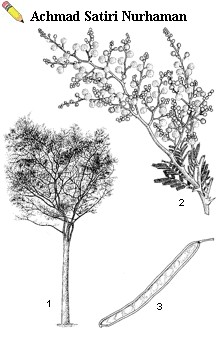Record Number
3918
PROSEA Handbook Number
5(2): Timber trees; Minor commercial timbers
Taxon
Acacia leucophloea (Roxb.) Willd.
This article should be read together with the article on the genus: Acacia in the Handbook volume indicated above in this database.
This article should be read together with the article on the genus: Acacia in the Handbook volume indicated above in this database.
Protologue
Sp. Pl. ed. 4, 4: 1083 (1806).
Synonyms
Acacia melanochaetes Zoll. (1846), Delaportea ferox Gagnep. (1852), Delaportea microphylla Gagnep. (1852).
Vernacular Names
Indonesia: pilang (Javanese, Sundanese), opilan (Madura), pelang (Madura, Bali). Burma (Myanmar): ta-noung. Thailand: chalaep-daeng (central), phayamai (Kanchanaburi). Vietnam: a bu, a kawa (Thuân Hai).
Distribution
Pakistan, Nepal, India, Sri Lanka, Burma (Myanmar), Vietnam, Thailand, Java, Madura, Timor and Sumbawa.
Uses
The wood is used as wattle, e.g. for indoor construction, flooring and furniture. It is appreciated as firewood and very suitable for manufacturing charcoal. More important is the use of the bark for tanning leather, for which it was formerly cultivated. The strong fibres have been used locally to manufacture fishing nets. The germinated seeds can be cooked and eaten as a vegetable. The pods and foliage are eaten by cattle. Stem and roots produce a gum used medicinally.
Observations
A medium-sized to fairly large deciduous tree up to 35 m tall, bole up to 100 cm in diameter, bark surface pale, lower branchlets with spinescent stipules; leaves bipinnate, with (4—)6—13 pairs of pinnae, each with 6—25 pairs of leaflets, with prominulous lateral veins below; flowers in pedunculate glomerules aggregated in terminal or axillary panicles, 5-merous, corolla 1.2—2 mm long; pod linear or strap-shaped, often falcate, 7—14 cm 0.8—1 cm, thinly woody. Acacia leucophloea is found in savanna or scrub vegetation, dry forest and teak forest, on well-drained often calcareous or sometimes sandy clayey soils, at 50—750 m altitude. The density of the wood is 710—890 kg/m3 at 15% moisture content. See also the table on wood properties.
Image
 | Acacia leucophloea (Roxb.) Willd. – 1, tree habit; 2, flowering branch; 3, pod. |
Selected Sources
[36]Backer, C.A. & Bakhuizen van den Brink, R.C., 1963–1968. Flora of Java. 3 volumes. Noordhoff, Groningen.
[162]Flora Malesiana (various editors), 1950–. Kluwer Academic Publishers, Dordrecht, Boston, London.
[163]Flore du Cambodge du Laos et du Viêtnam (various editors), 1960–. Muséum National d'Histoire Naturelle, Paris.
[261]Japing, H.W. & Oey Djoen Seng, 1936. Cultuurproeven met wildhoutsoorten in Gadoengan – met overzicht van de literatuur betreffende deze soorten [Trial plantations of non teak wood species in East Java – with survey of literature about these species]. Korte mededeelingen van het Boschbouwproefstation no. 55, part I to VI. Buitenzorg. 270 pp.
[369]Lemmens, R.H.M.J. & Wulijarni-Soetjipto, N. (Editors), 1991. Plant resources of South-East Asia No 3. Dye and tannin-producing plants. Pudoc, Wageningen. 195 pp.
[474]Oey Djoen Seng, 1951. Perbandingan berat dari jenis-jenis kaju Indonesia dan pengartian beratnja kaju untuk keperluan praktek [Specific gravity of Indonesian woods and its significance for practical use]. Laporan No 46. Balai Penjelidikan Kehutanan, Bogor. 183 pp.
[526]Research Institute of Wood Industry, 1988. Identification, properties and uses of some Southeast Asian woods. Chinese Academy of Forestry, Wan Shou Shan, Beijing & International Tropical Timber Organization, Yokohama. 201 pp.
[575]Smitinand, T. & Larsen, K. (Editors), 1970–. Flora of Thailand. The Forest Herbarium, Royal Forest Department, Bangkok.
[649]Turnbull, J.W., 1986. Multipurpose Australian trees and shrubs. Lesser known species for fuelwood and agroforestry. Australian Centre for International Agricultural Research, Canberra. 316 pp.
[162]Flora Malesiana (various editors), 1950–. Kluwer Academic Publishers, Dordrecht, Boston, London.
[163]Flore du Cambodge du Laos et du Viêtnam (various editors), 1960–. Muséum National d'Histoire Naturelle, Paris.
[261]Japing, H.W. & Oey Djoen Seng, 1936. Cultuurproeven met wildhoutsoorten in Gadoengan – met overzicht van de literatuur betreffende deze soorten [Trial plantations of non teak wood species in East Java – with survey of literature about these species]. Korte mededeelingen van het Boschbouwproefstation no. 55, part I to VI. Buitenzorg. 270 pp.
[369]Lemmens, R.H.M.J. & Wulijarni-Soetjipto, N. (Editors), 1991. Plant resources of South-East Asia No 3. Dye and tannin-producing plants. Pudoc, Wageningen. 195 pp.
[474]Oey Djoen Seng, 1951. Perbandingan berat dari jenis-jenis kaju Indonesia dan pengartian beratnja kaju untuk keperluan praktek [Specific gravity of Indonesian woods and its significance for practical use]. Laporan No 46. Balai Penjelidikan Kehutanan, Bogor. 183 pp.
[526]Research Institute of Wood Industry, 1988. Identification, properties and uses of some Southeast Asian woods. Chinese Academy of Forestry, Wan Shou Shan, Beijing & International Tropical Timber Organization, Yokohama. 201 pp.
[575]Smitinand, T. & Larsen, K. (Editors), 1970–. Flora of Thailand. The Forest Herbarium, Royal Forest Department, Bangkok.
[649]Turnbull, J.W., 1986. Multipurpose Australian trees and shrubs. Lesser known species for fuelwood and agroforestry. Australian Centre for International Agricultural Research, Canberra. 316 pp.
Author(s)
F. Arentz
Correct Citation of this Article
Arentz, F., 1995. Acacia leucophloea (Roxb.) Willd.. In: Lemmens, R.H.M.J., Soerianegara, I. and Wong, W.C. (Editors): Plant Resources of South-East Asia No 5(2): Timber trees; Minor commercial timbers. PROSEA Foundation, Bogor, Indonesia. Database record: prota4u.org/prosea

All texts are licensed under a Creative Commons Attribution-Noncommercial-Share Alike 3.0 Netherlands License
This license does not include the illustrations (Maps,drawings,pictures); these remain all under copyright.